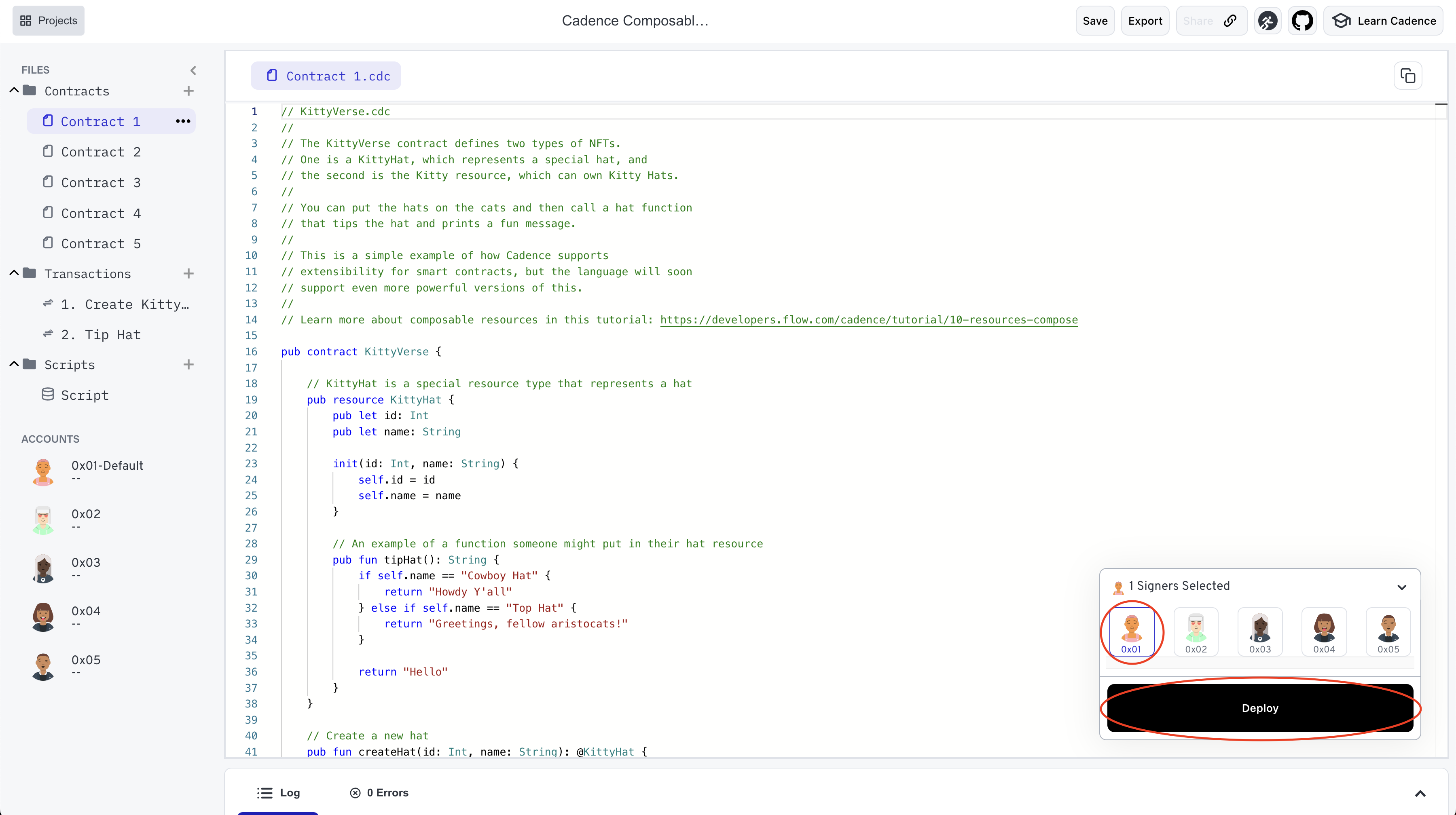10. Composable Resources
In this tutorial, we're going to walk through how resources can own other resources by creating, deploying, and moving composable NFTs.
Open the starter code for this tutorial in the Flow Playground:
https://play.onflow.org/01f812d7-799a-42fd-b9cb-9ffe556e02ad
The tutorial will be asking you do take various actions to interact with this code.
Instructions that require you to take action are always included in a callout box like this one. These highlighted actions are all that you need to do to get your code running, but reading the rest is necessary to understand the language's design.
Resources owning other resources is a powerful feature in the world of blockchain and smart contracts. To showcase how this feature works on Flow, this tutorial will take you through these steps with a composable NFT:
- Deploy the
KittyandKittyHatdefinitions to account0x01 - Create a
Kittyand twoKittyHats and store them in your account - Move the Kitties and Hats around to see how composable NFTs function on Flow
Before proceeding with this tutorial, we recommend following the instructions in Getting Started and Hello, World! to learn about the Playground and Cadence.
Resources Owning Resources
The NFT collections talked about in Non-Fungible Tokens are examples of resources that own other resources. We have a resource, the NFT collection, that has ownership of the NFT resources that are stored within it. The owner and anyone with a reference can move these resources around, but they still belong to the collection while they are in it and the code defined in the collection has ultimate control over the resources.
When the collection is moved or destroyed, all of the NFTs inside of it are moved or destroyed with it.
If the owner of the collection transferred the whole collection resource to another user's account, all of the tokens will move to the other user's account with it. The tokens don't stay in the original owner's account. This is like handing someone your wallet instead of just a dollar bill. It isn't a common action, but certainly is possible.
References cannot be created for resources that are stored in other resources. The owning resource has control over it and therefore controls the type of access that external calls have on the stored resource.
Resources Owning Resources: An Example
The NFT collection is a simple example of how resources can own other resources, but innovative and more powerful versions can be made.
An important feature of CryptoKitties (and other applications on the Ethereum blockchain) is that any developer can make new experiences around the existing application. Even though the original contract didn't include specific support for CryptoKitty accessories (like hats), an independent developer was still able to make hats that Kitties from the original contract could use.
Here is a basic example of how we can replicate this feature in Cadence:
- Open Contract 1, the
KittyVerse.cdccontract - In the bottom right deployment modal, press the arrow to expand and make sure account
0x01is selected as the signer. - Click the Deploy button to deploy the contract to account
0x01

The deployed contract should have the following contents:
These definitions show how a Kitty resource could own hats.
The hats are stored in a variable in the Kitty resource.
_10 // place where the Kitty hats are stored_10 pub var items: <-{String: KittyHat}
A Kitty owner can take the hats off the Kitty and transfer them individually. Or the owner can transfer a Kitty that owns a hat, and the hat will go along with the Kitty.
Here is a transaction to create a Kitty and a KittyHat, store the hat in the Kitty, then store it in your account storage.
- Open
Transaction1.cdc. - Select account
0x01as the only signer. - Send the transaction by clicking the Send button.
The transaction you sent just executed the following code:
You should see an output that looks something like this:
_10> "The Cat has the Hats"
Now we can run a transaction to move the Kitty along with its hat, remove the cowboy hat from the Kitty, then make the Kitty tip its hat.
- Open
Transaction2.cdc. - Select account
0x01as the only signer. - Send the transaction.
In this transaction, we executed the following code:
You should see something like this output:
_10> "Howdy Y'all"_10> "Greetings, fellow aristocats!"
Whenever the Kitty is moved, its hats are implicitly moved along with it. This is because the hats are owned by the Kitty.
The Future is Meow! Extensibility is coming!
The above is a simple example of composable resources. We had to explicitly say that a Kitty could own a Hat in this example, but in the near future, Cadence will support more powerful ways of achieving resource extensibility where developers can declare types that separate resources can own even if the owning resource never specified the ownership possibility in the first place. This is a very complex problem to solve in a safe way, and the Flow community is working very hard to design a solution for this, but it is coming.
Practice what you're learned in the Flow Playground!